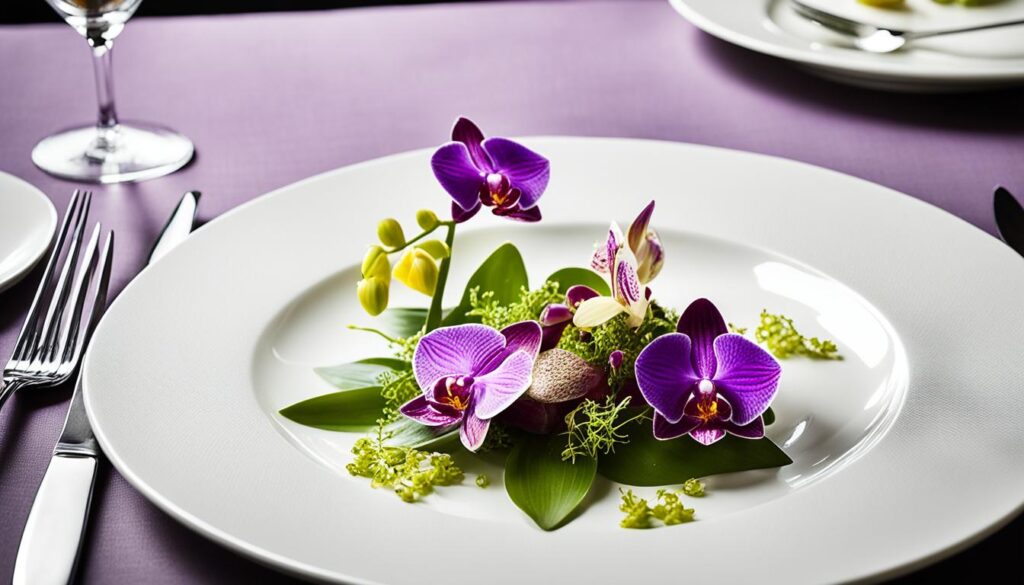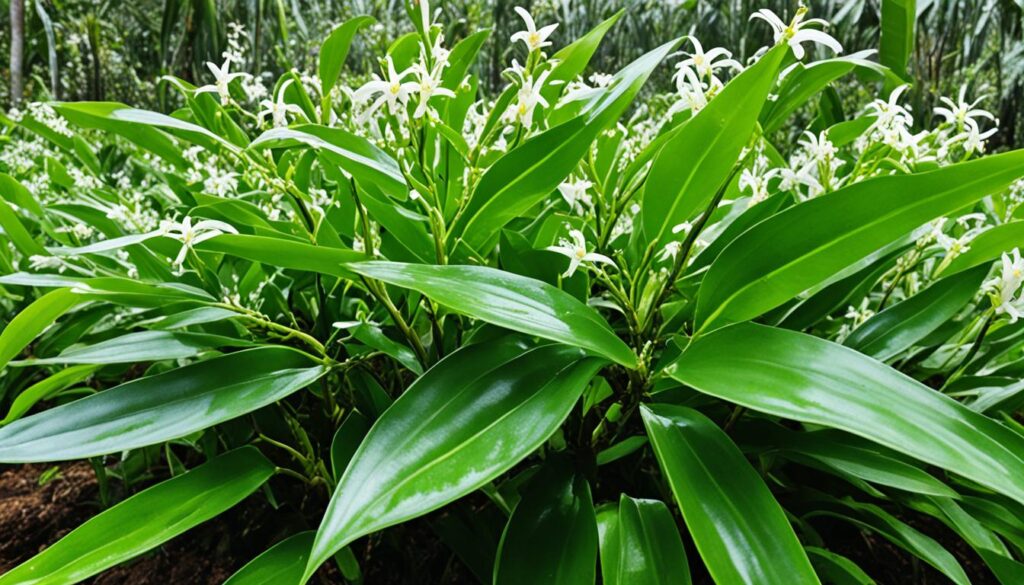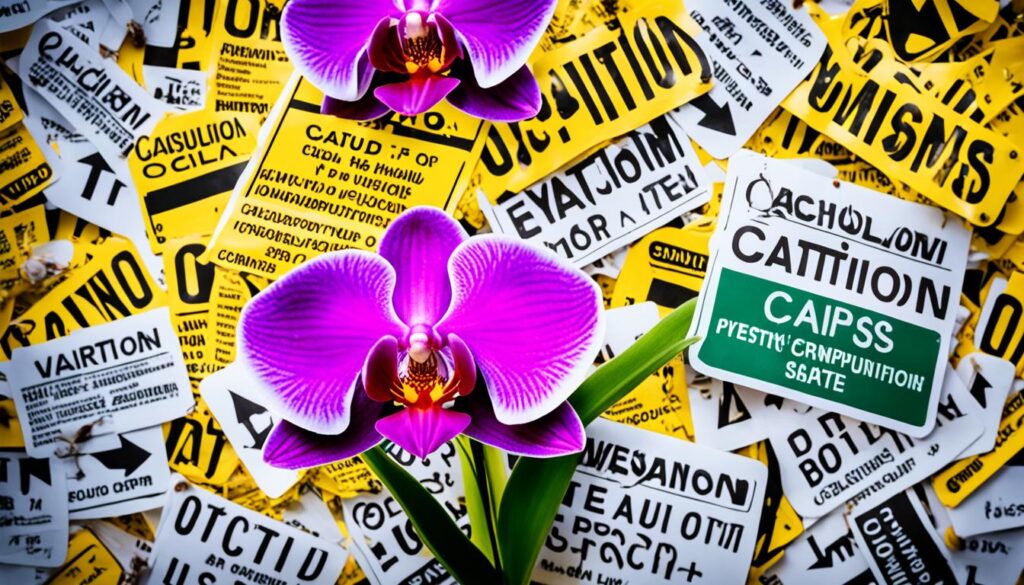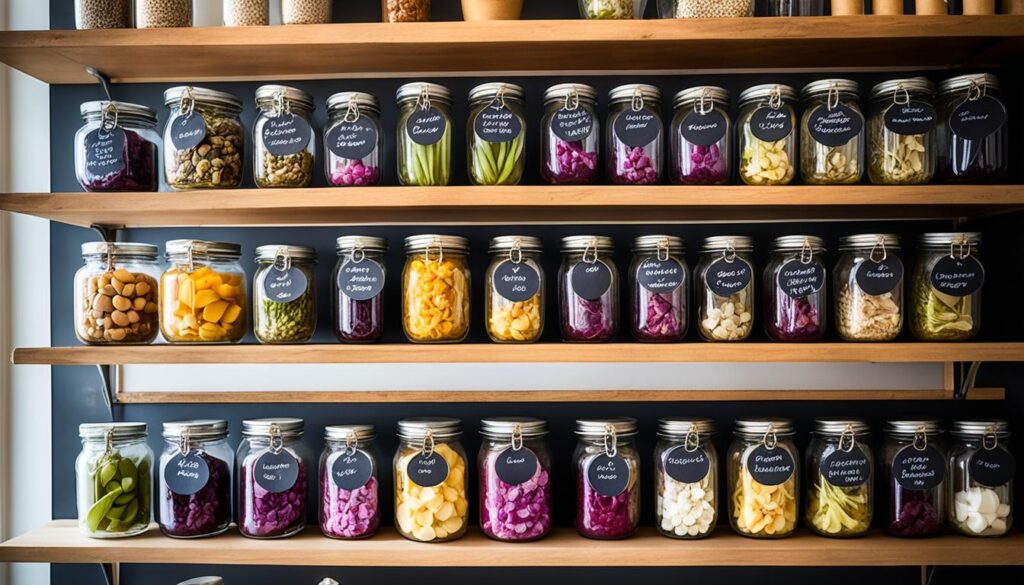Believe it or not, orchids, those exotic, ethereal blooms that epitomize grace and beauty, are more than just a feast for the eyes. In fact, not only are orchids edible, but they have been gracing plates for centuries with their delicate flavors and stunning yet subtle presence in dishes around the world.
Amid the burgeoning trend of using flowers in cooking, edible orchid plants feature prominently.
They lend themselves to a spectrum of orchid culinary uses, from contemporary fine dining to traditional specialties, proving that their appeal extends far beyond their visual charm.
As I explore the varied dimensions of these culinary gems, I am continually fascinated by the way orchids can transform a simple meal into an extraordinary experience.
Their versatility in the kitchen defies the limited understanding many have of these plants.
This comprehensive guide aims to illuminate the multiple aspects of edible orchids, inspiring both the adventurous foodie and the skeptical gourmand to push the boundaries of taste and presentation.
Key Takeaways
- A surprising variety of orchid species are not only safe but delightful to consume, offering unique flavors and textures.
- Understanding which orchids are edible is essential to safe consumption and heightening culinary experiences.
- Orchids have found their way into many facets of food preparation, serving as ingredients, garnishes, and even central elements of dishes.
- The most widely recognized edible orchid, Vanilla planifolia, is renowned for its indispensable flavoring derived from its pods.
- Beyond taste, orchids have a place in traditional medicine and are valued for their potential health benefits.
- Practising safe consumption and handling of orchids helps prevent the risks of allergic reactions or side effects.
- Proper storage and preservation techniques are key to maintaining the integrity of orchids’ flavor and appearance for culinary use.
Introduction to Edible Orchids
Orchids, with their stunning variety and ethereal beauty, have long captivated the attention of botanists and plant lovers alike.
Beyond their decorative uses, these charming plants harbor a fascinating culinary potential, leading many to wonder, can you eat orchids?
Indeed, the concept of orchid edibility is one that intrigues those adventurous in spirit and keen on expanding their epicurean horizons.
As we delve into the realm of orchid food sources, we uncover how these blooms go beyond aesthetics to offer unique taste experiences.
Why Consider Orchids as Food?
The very idea of consuming such exquisite creations might seem sacrilegious to some, but orchids have been a part of the human diet in various cultures for centuries.
The allure goes beyond the visual; it is an exploration of flavor, texture, and culinary innovation.
Orchids present an opportunity to bring a touch of the exotic to the table, infusing dishes with vibrancy and the promise of a gustatory revelation rarely paralleled by more conventional greens or flowers.
- Orchid petals can introduce a subtle, floral sweetness to salads and desserts.
- The stems, when cooked, provide a satisfying crunch akin to certain vegetables.
- Orchid bulbs, known as salep, have been used to thicken beverages and impart a rich, velvety texture.
As we expand our culinary repertoire, the question shifts from “Can you eat orchids?” to “How can we wonderfully incorporate them into our meals?”
Whether as a garnish or a central component, orchids bring a refreshing change to our plates and palates, a testament to nature’s endless bounty.
Understanding Orchid Edibility
Embarking on the exploration of orchid consumption, I’ve discovered a fascinating intersection of gourmet adventure and cultural tradition.
Edible flowers, particularly orchids, spark dining table conversations and pique culinary curiosity, but understanding the intricacies of their edibility is essential.
Starting with the basics, it’s important to ascertain whether are orchids safe to eat and recognize the significance of these edible flowers orchids in diverse cuisines.
Safety of Consuming Orchids
Before indulging in the floral bounty of orchids, ensuring safety is paramount. Not all orchids are created equal in the edible flower realm.
It’s about recognizing safe species and the appropriate parts to relish, typically the flowers free from plant sap.
Orchids should be introduced to one’s diet cautiously, taking slow steps to observe potential allergic reactions with the same prudence one would observe when integrating any new food item, especially when navigating the world of orchid consumption for the first time.

Nutritional Benefits of Orchids
Delving deeper, I encountered the nutritional aspect of orchids, drawing parallels with other edible flowers that are not only a feast to the eyes but also a source of nourishment.
Though scientific research on orchid-derived nutrition might be sparse, they are known to contain fiber, vitamins, and minerals, contributing to the holistic value of meals.
It piqued my interest in integrating them into my recipes as a means of enhancing nutritional content, beyond just their ornamental beauty.
Orchids in Traditional and Modern Cuisine
The use of orchids in food spans across many regions and eras, weaving into the fabric of both traditional and modern culinary arts.
They bring an authentic flair to the tabletop, creating an immersive cultural eating experience.
From the subtlety of Orchid petals in Asian dishes to the bold statement they make on contemporary fine dining plates, orchids challenge the conventional palate.
To appreciate how orchids fit into today’s gastronomy, one only has to peer into the kitchens of innovative chefs, where orchid consumption is embraced with open arms and imaginative minds.
- Historical significance of orchids in cultural dishes
- Aesthetic appeal and sensory enhancement in modern cuisine
- A guide to pairing orchids with various food elements for complementary flavors
This journey through the world of orchids in the culinary sphere has not just significant value in terms of safety and nutrition but also a rich historical and cultural perspective.
As I infused orchids into my cooking, I found that they indeed have the potential to transcend traditional boundaries, inviting a new paradigm of flavor and artistry to the plate.
Identifying Edible Orchids
As we venture into the realm of edible flower orchids, identifying the right species is crucial.
Catering to the growing trend of using flowers for culinary creativity, understanding which orchids are edible is essential for gourmands and food enthusiasts alike.
Let’s delve into the world of edible orchids and discover how to distinguish safe varieties from their inedible counterparts.
Popular Edible Orchid Varieties
Among the myriad of orchid species, only a select few are renowned for being edible and palate-friendly.
The iconic Vanilla planifolia is foremost among these, known for its seed pods that are the primary source of natural vanilla flavoring.
However, beyond this well-known variety, several other orchids also share the title of being fit for consumption. Let’s explore some of these varieties:
- Dendrobium: A genus with certain species that are widely used as a tasty treat in Southeast Asian cuisine.
- Cymbidium: Esteemed for their large, fleshy flowers, they are often used as a delicate decoration on plates and desserts.
- Epidendrum: These orchids are sometimes used as edible decoration or infused in syrups.

How to Distinguish Edible from Non-Edible Orchids
The task of distinguishing between edible and non-edible orchids may seem daunting due to the vast diversity within the Orchidaceae family.
To ensure safety and avoid any health risks, it is crucial to adhere to expert guidance and recognized culinary references when selecting orchids for consumption:
- Consult Recognized Guides: Turn to botanical guides or trusted culinary sources to ensure the species in question is edible.
- Scientific Names: Familiarize yourself with the scientific names of edible orchids to avoid any mix-ups with potentially toxic varieties.
- Professional Advice: Seek out professional advice if you’re dining in the wild, as some edible orchids can look similar to inedible ones.
- Origin: Be mindful of the orchid’s origin, as those sourced from the wild may not be safe due to potential chemical exposures or endangered status.
Identifying edible orchids is not only about safety but also about unlocking the full gastronomic potential of these exquisite plants.
By harnessing the visual and flavor appeal of edible flower orchids, chefs and home cooks can transform ordinary dishes into extraordinary experiences.
Always remember: To reap the benefits of these natural beauties, ensure they are indeed the varieties that are orchids edible and safe.
Culinary Uses of Orchids
The allure of edible orchid plants extends far beyond their visual appeal, carving a niche within the culinary arts where they are cherished for both their aesthetic and gastronomic qualities.
As we explore the diverse orchid culinary uses, it becomes evident that these blooms are more than just decorative elements; they are versatile ingredients that offer a plethora of possibilities for the adventurous chef and culinary enthusiast alike.
Orchids as Garnishes
A simple yet effective use of edible orchids is as garnishes. Their vibrant colors and unique shapes add an exotic touch to plates, drawing the eye and enhancing the overall presentation of a dish.
Whether delicately placed atop a frothy cocktail or adorning a gourmet salad, orchids serve to elevate the culinary experience with their natural beauty.
Enhancing Flavor Profiles with Orchids
The use of orchids in cooking is not just about visual enhancement; these edible flowers can also contribute nuanced flavors.
They can introduce subtle floral notes to a dish, thus enhancing flavor profiles in a way that intrigues the palate.
Incorporating orchids into sauces, marinades, and dressings can infuse them with a hint of elegance that is both unexpected and delightful.
Orchid-Based Desserts and Sweets
Among the various orchid food sources, orchid-based desserts and sweets stand out for their imaginative and delectable nature.
From crystalized orchid petals to orchid-infused syrups, these edible blooms can transform ordinary desserts into masterful confections.
Their grace and delicate flavors lend themselves particularly well to the creation of elegant pastries and luxurious frozen treats.
Innovative Orchid Recipes for Every Meal
Edible orchids are not confined to the realm of food styling or sweet treats; they can be integral components of savory dishes as well.
They flawlessly adapt to a wide range of recipes from every culture, gracing everything from aromatic
Asian stir-fries to contemporary fusion entrées. Below is an illustration of how you might incorporate orchids into a meal:
- Start with a breakfast of orchid-infused yogurt topped with a sprinkling of granola and fresh fruit.
- For lunch, prepare a vibrant Thai orchid salad featuring julienned vegetables, herbs, and a zesty lime dressing.
- Come dinner, present a grilled fish dish garnished with an orchid mango salsa, combining sweetness with a floral zing.
- End the day with a delicate orchid petal sorbet that cleanses the palate and delights the senses.

The Special Case of Vanilla
Within the fascinating world of edible orchids, the Vanilla planifolia holds a unique position of distinction.
As the source of one of the most cherished flavors in the world, vanilla orchids are not just a culinary delight; they represent a complex journey from flower to flavor.
Vanilla: The Most Famous Edible Orchid
The journey of vanilla began with the cultivation of vanilla orchids, primarily in lush tropical regions where conditions mirror their native habitats.
Historically, the Totonac people of Mexico were the first to cultivate vanilla. Today, however, regions such as Madagascar and Indonesia have become renowned for their vanilla production.
As the tendrils of the Vanilla planifolia climb and bloom, their inherent beauty is matched only by the potential they hold within their pods.

From Orchid to Vanilla Extract: A Process Overview
The process from orchid to vanilla extract has remained largely unchanged over centuries, a testament to its artisanal nature.
What begins as a delicate flower on the vine must be hand-pollinated, a skillful method necessary for the production of the vanilla pods.
Once the vanilla pods have matured, they undergo a meticulous curing process.
This includes sun-drying during the day, sweating in cloth to foster heat-induced enzymatic reactions at night, and a final drying stage to fully develop the rich flavors and aromas.
| Stage | Description | Duration |
|---|---|---|
| Pollination | Manual fertilization of the vanilla orchid flowers. | 1 day |
| Pod Maturity | Maturation of vanilla pods on the vine. | 8-9 months |
| Curing | Sun-drying and sweating processes to develop flavor. | Several weeks to several months |
| Conditioning | Final maturation phase to enhance fragrance. | Up to 6 months |
The resulting product is a dark, fragrant, and flavorful substance that is utilized in countless recipes and commercial products.
The unmistakable taste of vanilla extract, derived from the fruit of Vanilla planifolia, enhances everything from baked goods to perfumes, solidifying its status as the world’s favorite flavor.
Health Benefits of Orchids
The allure of orchids goes beyond their exotic beauty, extending into the realm of health and wellness.
Reputed for their medicinal properties, these breathtaking plants have carved a niche in traditional healing practices.
While modern research has yet to fully validate these claims, the intrigue surrounding the nutritional benefits of edible orchid plants reflects a broader quest for natural wellness solutions.
Encounters with orchids don’t just please the eye but could potentially nourish the body.

Orchids in Traditional Medicine
Throughout history, orchids have assumed a significant role in various medicinal practices.
Cultures across the world have traditionally used different parts of the orchid, particularly the roots and flowers, to address a range of health issues.
There’s a sense of mystique in the way these plants have been employed, from enhancing vitality to purportedly curing maladies.
Let’s deftly separate the petals of fact from fiction as we explore how orchids have been revered for their therapeutic potential.
Nutritional Value and Health Implications
The discussion around orchid consumption often blooms into a conversation about its potential health benefits.
There’s anticipation in the air; after all, if something as enchanting as an orchid could also bolster health, wouldn’t we be living in a wonderland of well-being?
Orchids are more than a masterpiece of evolution, they may harbor a bouquet of beneficial nutrients. Encouraging preliminary findings suggest a spectrum of health implications, signaling a budding field ripe for exploration.
As we probe the depths of orchid edibility, we unearth a symphony of possibilities that could harmonize health and taste.
Precautions and Considerations
When exploring the intriguing world of edible flowers, one might ask, “Can you eat orchids?” The answer is yes but with some important caveats.
Orchids can indeed be savored, provided they are approached with caution and knowledge.
As with any lesser-known edible, I advocate for safety first, setting the stage for a delightful experience rather than an adverse one.
Safe Consumption Practices
Safety begins with comprehensive knowledge about the source of your orchids.
Those intended for consumption should be free from pesticides and chemical treatments, which means purchasing from trusted growers or suppliers who specialize in edible plants.
Always inquire about the growing conditions and handling methods of any orchids you plan to eat.
Important Note: Before incorporating orchids into your diet, always consult with a knowledgeable botanist or a trusted source to ensure the variety you have is indeed safe for consumption.
Potential Allergies and Side Effects
Like any new addition to your diet, edible orchids can have unexpected effects, particularly for those with sensitivities or allergies.
The symptoms may range from mild discomfort to more severe allergic reactions.
To mitigate this, I recommend introducing orchids slowly into your diet and observing how your body responds, paying extra attention to any signs of a negative reaction.
An especially important part of the orchid that can be a trigger for allergies is the pollen, so it’s often removed before consumption.
Let’s look at a comparison between the consumable and non-consumable parts of an orchid:
| Consumable Orchid Parts | Non-Consumable Orchid Parts |
|---|---|
| Petals (after ensuring edibility) | Pollen (can trigger allergies) |
| Stems (found in some varieties) | Rhizomes/Roots (of most species) |
| Seeds (in culinary products like vanilla) | Leaves (generally not recommended) |
To conclude, while the prospect of adding orchids to your diet is indeed enticing and can spark culinary creativity, remembering the adage ‘safety first’ is paramount.
Always conduct due diligence, are orchids safe to eat, and take measured steps when enjoying these exotic delights.

Storing and Preserving Edible Orchids
As a culinary enthusiast, I’ve come to appreciate the importance of storing edible flowers to maintain their freshness.
Preserving the delicate nature of edible orchid plants is key to ensuring that their unique flavor and aesthetic appeal remain intact from farm to table.
Let’s delve into the best practices for extending the shelf life of these floral delicacies.

Best Practices for Storage
To preserve the vibrancy and taste of edible orchids, implementing proper storage techniques immediately after harvesting is crucial.
I recommend placing orchids in a dedicated section of the refrigerator, as this slows down the aging process and preserves their petals’ integrity.
It’s optimal to wrap them gently in a moist paper towel before storing them in a rigid container, to balance moisture while avoiding bruising.
Extending Shelf Life of Orchid Products
While fresh orchids offer the brightest flavors and most vivid colors, there are also methods to extend their shelf life for ongoing culinary use.
Drying and candying these flowers enables us to enjoy them long after their typical freshness window has passed.
Below is a table outlining some of my personal best practices for preserving orchids.
| Preservation Method | Benefits | Expected Shelf Life |
|---|---|---|
| Refrigeration | Preserves freshness; ready-to-use | Up to 1 week |
| Drying | Concentrates flavor; versatile use | Several months |
| Candying | Enhances sweetness; decorative | 3-6 months |
| Freezing (in syrup) | Retains color and texture; longer storage | Up to 1 year |
By following these guidelines for storing edible flowers and maximizing the longevity of our precious edible orchid plants, we can ensure these culinary treasures remain a part of our creative cooking repertoire for as long as possible.
FAQ
Why Consider Orchids as Food?
Exploring orchids as a food source is a fascinating endeavor. These exotic plants are more than just a visual feast; certain species provide unique flavors and textures that can enhance culinary creations. As an addition to dishes or as a stand-alone ingredient, edible orchids offer a new dimension of taste along with aesthetic elegance. From their application as garnishes to their use in flavoring dishes, orchids are a testament to the versatility and innovation in modern gastronomy.
Safety of Consuming Orchids
The safety of consuming orchids, like any food item, is paramount. When considering orchids for culinary use, it is essential to know the specific varieties that are safe for consumption and to be certain they are free from pesticides or other harmful treatments. Proper identification and sourcing from reputable suppliers can help ensure that the orchids you consume are edible and safe.
Nutritional Benefits of Orchids
Edible orchids can provide nutritional benefits typical of many flowers and plants. Orchids have been noted for their fiber content and various compounds that may have health benefits. However, it is important to note that the nutritional content can differ among species, and orchids should be consumed as part of a varied and balanced diet.
Orchids in Traditional and Modern Cuisine
Orchids have held a place in both traditional and contemporary cuisines across the world. In some cultures, orchid tubers are ground to make a flour or are used for their texture and flavor. Orchids are also a staple in modern fine dining, offering a luxurious experience both visually and on the palate.
Popular Edible Orchid Varieties
One of the most popular edible orchid varieties is Vanilla planifolia, used for vanilla flavoring. Other than vanilla, the Dendrobium genus is another type of orchid that is often consumed, either crystallized or fresh in salads. It’s critical to research and consult experts to identify other edible varieties, as there are many types of orchids, not all of which are fit for consumption.
How to Distinguish Edible from Non-Edible Orchids
Distinguishing edible from non-edible orchids requires a good understanding of the specific species. The key is to rely on botanical names rather than common names, which can be vague or misleading. Consulting resources such as botanical guides or specialists in edible flowers can help ensure that you are choosing the right orchids for culinary use.
Orchids as Garnishes
Orchids can make extraordinary garnishes due to their vibrant colors and elegant forms. They can add a touch of sophistication to both sweet and savory dishes, creating visual appeal that elevates the dining experience. When used as garnishes, it’s essential to choose orchids that are not only beautiful but also edible and flavorful.
Enhancing Flavor Profiles with Orchids
Orchids can be used to enhance flavor profiles in a variety of dishes. For example, vanilla, which is derived from the Vanilla orchid, is a popular flavoring used worldwide. Other edible orchids might impart a more subtle taste and are used to complement other flavors in the dish rather than overshadow them.
Orchid-Based Desserts and Sweets
In the realm of desserts and sweets, orchids can play a starring role. Candied orchid petals are a classic treat, providing a sweet crunch that pairs wonderfully with cakes, ice creams, and pastries. Some chefs use orchid essence or infuse creams and syrups with orchid flavors to create unique and memorable desserts.
Innovative Orchid Recipes for Every Meal
Orchids can be incorporated into recipes for any meal, offering a unique twist to traditional dishes. From adding fresh orchid petals to salads to infusing broths with orchid flavors, there are endless possibilities for those looking to experiment with these edible flowers in their cooking.
Vanilla: The Most Famous Edible Orchid
Vanilla is undoubtedly the most famous edible orchid, playing an essential role in countless recipes and products. Its wide-ranging popularity stems from its delightful fragrance and complex flavor, which makes it a versatile ingredient in both sweet and savory dishes.
From Orchid to Vanilla Extract: A Process Overview
Producing vanilla extract from the Vanilla orchid is a process that involves curing and drying the plant’s pods. This intricate procedure enhances the natural flavor compounds, which are later extracted into a solution to make the vanilla extract that is prized in culinary uses around the world.
Orchids in Traditional Medicine
In various traditional medicine systems, orchids have been used for their purported medicinal properties. Different parts of the plant, such as the roots and flowers, have been used to address a range of health concerns. Although modern science may not fully endorse these uses, many cultures continue to value orchids for their potential health benefits.
Nutritional Value and Health Implications
While there is limited research on the nutritional value of orchids, edible varieties are believed to contribute dietary fiber and unique compounds that could have health implications. As with any food source, it is recommended to enjoy orchids as part of a comprehensive approach to a healthy diet.
Safe Consumption Practices
To safely consume edible orchids, it’s important to source them from reputable places where they are grown without harmful chemicals. Proper identification and preparation are also key to ensuring that only edible parts are consumed.
Potential Allergies and Side Effects
As with any new addition to the diet, consuming orchids could potentially trigger allergies in some individuals. It’s a good practice to introduce them gradually and to be alert to any adverse reactions, especially when consuming orchids for the first time.
Best Practices for Storage
To maintain the freshness and quality of edible orchids, they should be stored in the refrigerator in a rigid container lined with a moist paper towel. This environment helps to keep the orchids hydrated and extends their shelf life.
Extending Shelf Life of Orchid Products
The shelf life of orchid products like vanilla extract can be extended through proper storage. Keeping them in cool, dark places away from direct sunlight and heat will preserve their flavor and potency for a longer period.
Can All Orchid Species Be Eaten?
No, not all orchid species are edible. It’s crucial to research and identify the varieties that are safe for consumption as well as consume them in moderation as part of a varied diet.
How to Prepare Orchids for Consumption
To prepare orchids for consumption, wash them carefully to remove any dirt or debris. Then, remove any non-edible parts like stamens, pistils, and sepals. It’s essential to use only the petals of orchids that are known to be safe for eating.
Are There Any Orchids That Should Be Avoided?
Yes, some orchids should be avoided due to toxicity or unpalatability. Only a few orchid varieties like Vanilla planifolia (used for vanilla flavoring) and select species of Dendrobium are known to be edible. Always ensure you have conclusively identified an orchid as edible before consuming it.


Leave a Reply